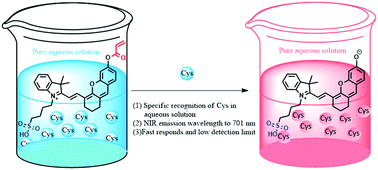A near-infrared fluorescent probe for the discrimination of cysteine in pure aqueous solution and imaging of cysteine in hepatocellular carcinoma cells with facile cell-compatible ability†
Abstract
A unique near-infrared fluorescence sensor named AySA was designed and synthesized for selectively detecting cysteine over Hcy and GSH in aqueous solution with fast response and long emission wavelength of 701 nm. In this strategy of designing the probe, sulfonic acid was introduced to the cyanine structure through multiple methylene flexible chains as the water soluble functional group, and an acryl group was introduced through nucleophilic substitution reaction to serve as an efficient reaction site for Cys. Finally, a new NIR fluorescence sensor was constructed for the discrimination of Cys in aqueous solution. The probe shows excellent properties in 100% aqueous solution. It shows evident discrimination of Cys over Hcy and GSH, which is accompanied with fluorescence intensity enhancement and visible color change. The detection limit was calculated for 21.1 nm using the linear relationship of concentration of 1–3 μM (3σ/κ). The proposed mechanism based on conjugated addition, intramolecular cyclization and the sensing mechanism was confirmed by high-resolution mass spectrometry. In addition, the probe can work at a wide range of pH 7–10 and react with Cys in a few minutes. The probe was also successfully applied to Bel 7402 imaging with low toxicity. An outstanding red fluorescence appeared when the Bel 7402 cells were incubated with the probe or when Cys was added to the NEM-pretreated cells, indicating that the probe has a good ability to penetrate cells and react with Cys quickly. Considering the above results, we have the confidence to say that the probe can be used as an ultra-sensitive, near-infrared fluorescence sensor to selectively sense Cys in pure aqueous solutions in living systems.



 Please wait while we load your content...
Please wait while we load your content...